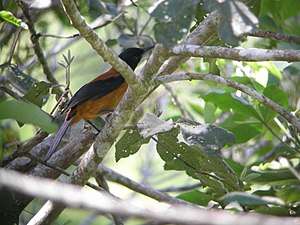Pitohui
The pitohuis /pɪtoʊˈwiː/[1] are bird species endemic to New Guinea. The onomatopoeic name is thought to be derived from that used by New Guineans from near Dorey (Manokwari) but it is also used as the name of a genus Pitohui which was established by the French naturalist René Lesson in 1831. The unitalicized common name however refers to perching birds that belong to several genera which belong to multiple bird families. The genera include Ornorectes, Melanorectes, and Pseudorectes apart from Pitouhi.[2]
Taxonomy and systematics
Six species were formerly classified together in the genus Pitohui, in the family Pachycephalidae. They were separated in 2013 when the genus and two of the species were re-classified in the family Oriolidae and three species remained in Pachycephalidae in the new genera of Melanorectes and Pseudorectes. One species was placed in the family Oreoicidae.[3]
The species are now separated into three families as follows:
Oreoicidae
- Crested pitohui (Ornorectes cristatus)
Pachycephalidae
- Black pitohui (Melanorectes nigrescens)
- White-bellied pitohui (Pseudorectes incertus)
- Rusty pitohui (Pseudorectes ferrugineus)
Oriolidae
- Northern variable pitohui (Pitohui kirhocephalus)
- Raja Ampat pitohui (Pitohui cerviniventris)
- Southern variable pitohui (Pitohui uropygialis)
- Hooded pitohui (Pitohui dichrous)
Description
They are brightly coloured, omnivorous birds. The hooded pitohui is brightly coloured, with a brick red belly and a jet-black head. The variable pitohui, as its name implies, exists in many different forms, and 20 subspecies with different plumage patterns have been named. Two of them, however, closely resemble the hooded pitohui.
Behaviour and ecology
The skin and feathers of some pitohuis, especially the variable and hooded pitohuis, contain powerful neurotoxic alkaloids of the batrachotoxin group (also secreted by the Colombian poison dart frogs, genus Phyllobates). These are believed to serve the birds as a chemical defence, either against ectoparasites or against visually guided predators such as snakes, raptors or humans.[4] The birds probably do not produce batrachotoxin themselves. The toxins most likely come from the beetle genus Choresine, part of the birds' diets.[5]
The birds' bright colours are suggested to be an example of aposematism (warning colouration), and the similarity of the hooded pitohui and some forms of the variable pitohui might then be an example of Müllerian mimicry, in which dangerous species gain a mutual advantage by sharing colouration, so an encounter with either species trains a predator to avoid both.[6]
Relationship to humans
Due to their toxicity, Papua New Guineans call the pitohuis rubbish birds as they are not good for eating; in desperate times, though, they can be consumed but only after the feathers and skin are removed and the flesh is coated in charcoal and then roasted. (Piper, 2007)
See also
References
- ↑ Birkhead, Tim (2012). Bird Sense: What it's like to be a bird. Bloomsbury Publishing. p. 120.
- ↑ Dumbacher, John P. (2014). "A taxonomic revision of the genus Pitohui Lesson, 1831 (Oriolidae), with historical notes on names" (PDF). Bull.B.O.C. 134 (1): 19–22.
- ↑ "Taxonomy 3.1-3.5 « IOC World Bird List". www.worldbirdnames.org. Retrieved 2017-01-29.
- ↑ (Dumbacher, et al., 1992)
- ↑ (Dumbacher, et al., 2004). Archived 2012-08-27 at the Wayback Machine.
- ↑ (Dumbacher & Fleischer, 2001)
- del Hoyo, J.; Elliot, A. & Christie D. (editors). (2007). Handbook of the Birds of the World. Volume 12: Picathartes to Tits and Chickadees. Lynx Edicions. ISBN 978-84-96553-42-2
- Dumbacher JP, Beehler BM, Spande TF, Garraffo HM, Daly JW (1992). "Homobatrachotoxin in the genus Pitohui: chemical defense in birds?". Science. 258 (5083): 799–801. doi:10.1126/science.1439786. PMID 1439786.
- Dumbacher JP, Fleischer RC (2001). "Phylogenetic evidence for colour pattern convergence in toxic pitohuis: Mullerian mimicry in birds?". Proceedings of the Royal Society of London B. 268 (1480): 1971–6. doi:10.1098/rspb.2001.1717. PMC 1088837. PMID 11571042.
- Dumbacher JP, Wako A, Derrickson SR, Samuelson A, Spande TF, Daly JW (2004). "Melyrid beetles (Choresine): a putative source for the batrachotoxin alkaloids found in poison-dart frogs and toxic passerine birds". Proceedings of the National Academy of Sciences. 101 (45): 15857–60. doi:10.1073/pnas.0407197101. PMC 528779. PMID 15520388.
- Piper, R. Extraordinary Animals: An Encyclopedia of Curious and Unusual Animals, Greenwood Press
External links
- Fugu, Poison Frogs, and Pitohuis by Harold B. White
- Picture of a hooded pitohui at the Wayback Machine (archive index)
